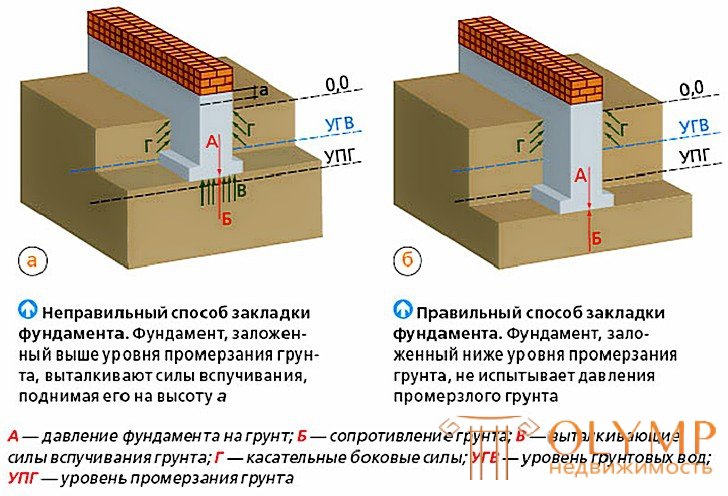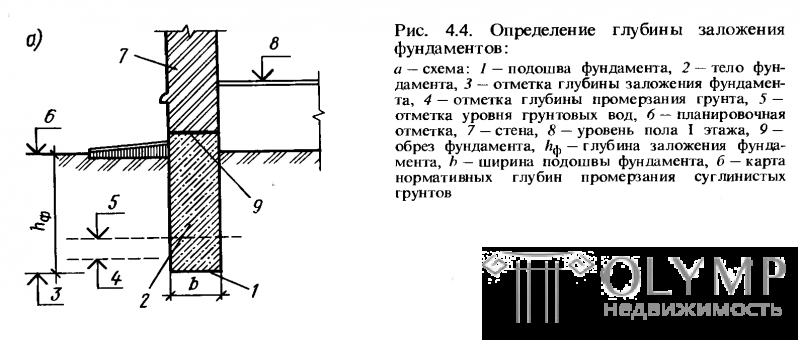
The depth of foundation of the foundations is determined by many factors and, first of all, by the engineering - geological and hydrogeological conditions of the site. When designing, it is necessary to take into account the properties of soils, their strength and deformation qualities, choosing soil as a carrier layer, which is a reliable foundation of structures. Therefore, it may sometimes be advisable to increase the depth of the foundation by cutting through the weak upper layers of the soil. Groundwater level mainly affects the way construction works, however, when setting the depth


laying should take into account the heaving soil. When the foundation bottom is laid below the groundwater level, it is necessary to drain the pit by open or deep water lowering. Rising groundwater levels also adversely affect the conditions of operation of the grounds: leads to a change in the properties of the soil, the occurrence of such adverse phenomena as subsidence or swelling. In many cases, especially for industrial buildings, the depth of laying the foundations of supporting structures is determined by the presence of underground utilities, basements, technological pit. In determining the depth of the foundation, account should be taken of the depth of the foundations of existing buildings adjacent to the designed structure. If it is necessary to very closely build a new building to an existing one, then it is necessary to position between them a protecting structure in the form of a sheet pile wall, a number of piles of which should be located much deeper than the bottom of the foundation below. Often there is a need to lay the foundations in the longitudinal direction at different elevations. Such a transition from the less recessed to the more recessed part is performed by ledges. The relationship of the height of the ledge to its length for clay soils is not less than 1: 2, and for sandy soils 1: 3.
The value and nature of the loads acting on the foundations also determine their depth. First of all, this refers to structures that perceive horizontal loading. In this case, it is possible to prevent the foundation from shifting along the base by corresponding its penetration.
The minimum depth depends on the depth of soil freezing. The freezing of heaving soils leads to an increase in their volume due to the formation of ice layers in them. Mainly fine and silty sands and silty clayey soils are subject to heaving. Practice shows that soil deformations within the building area during heaving and thawing are uneven. This is due to the heterogeneity of the soil, uneven thawing, different temperature conditions of the soil during operation of the structure. To avoid unfavorable deformations of the foundations caused by the freezing of the soil, it is possible when laying its sole below the depth of seasonal freezing of the soil. Regulatory depth of seasonal soil freezing  depends on the climatic conditions of the site, namely the type of soil and the values of negative tp in the winter period.
depends on the climatic conditions of the site, namely the type of soil and the values of negative tp in the winter period.
 =
= 
 where
where
 - freezing depth at
- freezing depth at  = 1, assumed equal for loam and clay to 0.23 m, for sandy loams, fine and silty sands 0.28 m, for coarse-grained soils 0.34 m.
= 1, assumed equal for loam and clay to 0.23 m, for sandy loams, fine and silty sands 0.28 m, for coarse-grained soils 0.34 m.
 - a dimensionless coefficient equal to the sum of the values of the average monthly negative temperatures for the winter period, taken according to the SNiP "Construction climatology and geophysics"
- a dimensionless coefficient equal to the sum of the values of the average monthly negative temperatures for the winter period, taken according to the SNiP "Construction climatology and geophysics"
When assigning the depth of the foundations using the estimated depth of freezing. The depth of soil freezing in the main structure differs from the corresponding depth in the open area. The reason for this is the entry of heat into the ground from the building. Therefore, the estimated depth of freezing is less than the normative and depends on the thermal regime of the structure and the constructive solution of the floors of the 1st floor of the building. The depth of freezing is determined by:
 =
=  *
*  where
where  - it is a coefficient equal to from 0.4 to 1 for the outer foundations of heated buildings. For the external foundations of unheated buildings, it is 1.1. The depth of the foundations of the inner walls and columns of heated buildings, counting from the surface of the layout, is set independently of the depth of soil freezing, provided that the soil during construction is protected from moisture and freezing.
- it is a coefficient equal to from 0.4 to 1 for the outer foundations of heated buildings. For the external foundations of unheated buildings, it is 1.1. The depth of the foundations of the inner walls and columns of heated buildings, counting from the surface of the layout, is set independently of the depth of soil freezing, provided that the soil during construction is protected from moisture and freezing.
Что бы оставить комментарий войдите
Комментарии (0)